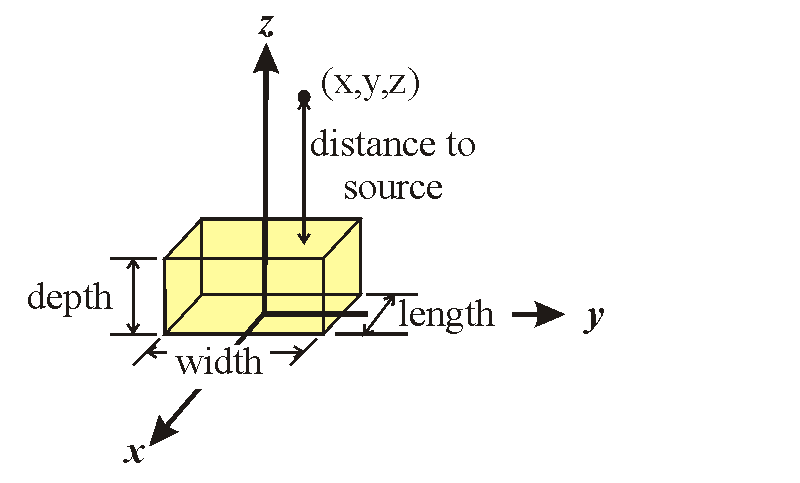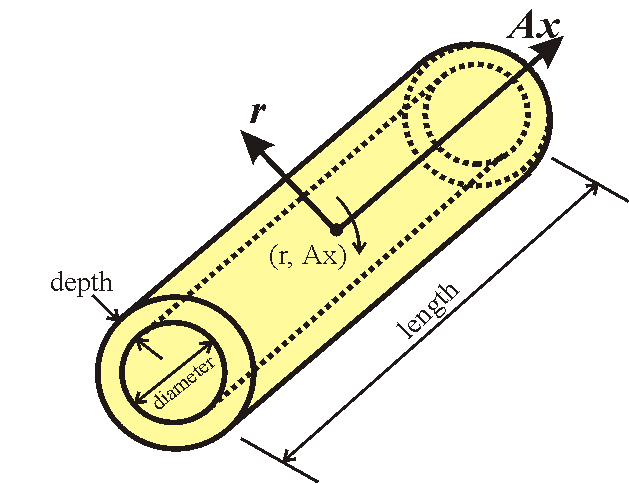The external radiation dose calculator calculates the radiation dose from a shielded gamma source with an evenly distributed concentration of radionuclides. For source and shield, a number of common materials and compositions of natural radionuclides can be selected, or a custom mix of elements and radionuclides can be entered. (Currently, the calculation gives incorrect results for gamma emitters in the shield. Therefore, only put radionuclides in the source! If you need radionuclides in the shield, run the program twice (once treating the shield as the source) and add the results).
Basic parameters are entered on the left (white) side of the table. Advanced parameters are entered on the right (grey) side of the table. Three versions of the calculator are available; one version models a rectangular slab source, another models the inside of an annular cylinder (drift in ore) source, and another calculates the thickness of shield required to obtain a given dose rate using an annular cylinder source. Once all parameters have been entered, the calculation is initiated by pressing the Calculate button. The calculation may take some time based on the number of integration steps chosen. Some browsers may produce a warning indicating that the script is taking a long time to run. Either change the settings on your browsers, some suggestions on how to do this is given later in this document, or dismiss the warnings and continue to allow the script to run. The result are displayed in the Results text area.
Do NOT use the Refresh button on your browser. (This results in an incomplete refresh.) If you want to refresh the page, close your browser window and open it again.
TOC


Information about the source can be entered in two ways: The grade of the ore can be specified (in %U3O8 or %U), or the advanced section can be used to specify various other materials. By default the advanced section is filled with the mix of elements and radionuclides required for a calculation based on ore grade. If you do not wish to use these values, the material may be changed either by selecting a predefined material from the drop down menu or by specifying elements and radionuclides in the table. (If the library does not contain an element or radionuclide that you entered, the results box will indicate a warning.)
When a material is selected from the drop down menu, the table is filled with
the elements and radionuclides that make up the given material. If the values
from the ore grade section are selected, the table reverts to its default
values. The table is composed of element names (e.g. U) and radionuclides (e.g.
U-238) along with their associated abundance in percent-weight or, for
radionuclides, their activity in Bq per gram of source material. An asterix (*)
preceding the number indicates that the number represents activity in Bq per
gram instead of percent-weight. A list of radionuclide compositions and radionuclide series that may be entered in
the table is given below.
TOC
| Element Compositions | ||
|---|---|---|
| Name | Description | Notes |
| Air | Air, Dry (Near Sea Level) | |
| Water | Water, Liquid | |
| Concr_od | Concrete, Ordinary | |
| Glass_Pb | Glass, Lead | |
| Glass_BS | Glass, Borosilicate ("Pyrex") | |
| Tiss_sft | Tissue, Soft (ICRU-44) | |
| St_304 | Type 304 Stainless Steel | |
| Soil_US | U.S. Soil | |
| Soil_05 | U.S. Soil with Ra-226 @ 5 pCi/g = 0.185 Bq/g (U-series in equil.) | 1) |
| Soil_15 | U.S. Soil with Ra-226 @ 15 pCi/g = 0.555 Bq/g (U-series in equil.) | 1) |
| Rock_cru | Rock, Crustal | |
| Uorenor | Uranium ore, Nordic Lake, Elliot Lake, Ontario, Canada | 2) |
| Uore01 | Uranium ore 0.1% U | 2) |
| Utail01 | Uranium mill tailings from 0.1% U ore, extraction = 90% | 2) |
| Utaildgo | Uranium mill tailings, Durango, Colorado, USA | |
| Utailnor | Uranium mill tailings, Nordic Lake, Elliot Lake, Ontario, Canada | |
| UF6_nat+ | Uranium hexafluoride, natural, solid, with short-lived progeny (Th-234, Pa-234m, Th-231) | |
| UF6_enr+ | Uranium hexafluoride, enriched to 3.5% U-235, solid, with short-lived progeny (Th-234, Pa-234m, Th-231) | |
| UF6_ere+ | Uranium hexafluoride, enriched to 3.5% U-235 equiv., solid, from recycled U (3.5% init.enr. 39 GWd/tHM, 5 y), with short-lived progeny (Th-228, Ra-224, Pb-212, Bi-212, Tl-208, Th-231, Th-234, Pa-234m) | |
| UF6_dep+ | Uranium hexafluoride, depleted to 0.2% U-235, solid, with short-lived progeny (Th-234, Pa-234m, Th-231) | |
| UF6_dre+ | Uranium hexafluoride, depleted to 0.2% U-235, solid, from recycled U (3.5% init.enr. 39 GWd/tHM, 5 y), with short-lived progeny (Th-231, Th-234, Pa-234m) | |
| U3O8_nat+ | U3O8, natural, with short-lived progeny (Th-234, Pa-234m, Th-231) | |
| U3O8_dep+ | U3O8, depleted to 0.2% U-235, with short-lived progeny (Th-234, Pa-234m, Th-231) | |
| UO2_enr+ | UO2, enriched to 3.5% U-235, with short-lived progeny (Th-231, Th-234, Pa-234m) | |
| UO2_ere+ | UO2, enriched to 3.5% U-235 equiv., from recycled U (3.5% init.enr. 39 GWd/tHM, 5 y), with short-lived progeny (Th-228, Ra-224, Pb-212, Bi-212, Tl-208, Th-231, Th-234, Pa-234m) | |
| Radionuclide Compositions | ||
|---|---|---|
| Name | Description | Notes |
| U_nat | Natural Uranium, without progeny | |
| U_nat+ | Natural Uranium, with short-lived progeny (Th-234, Pa-234m, Th-231) | |
| U_nat++ | Natural Uranium, with all major progeny in sec. equilibrium | |
| U_rec | Recycled Uranium, init. enr. 3.5%, burnup 39 GWd/tHM, 5 y delay | |
| U_rec+ | Recycled Uranium, init. enr. 3.5%, burnup 39 GWd/tHM, 5 y delay, with progeny | |
| U_dep | Depleted Uranium, 0.2 wt-% U-235, without progeny | |
| U_dep+ | Depleted Uranium, 0.2 wt-% U-235, with short-lived progeny (Th-234, Pa-234m, Th-231) | |
| U_dre | Depleted Recycled Uranium, 0.2% U-235, init. enr. 3.5%, burnup 39 GWd/tHM, 5 y delay | |
| U_dre+ | Depleted Recycled Uranium, 0.2% U-235, init. enr. 3.5%, burnup 39 GWd/tHM, 5 y delay, with short-lived progeny (Th-231, Th-234, Pa-234m) | |
| U_enr | Enriched Uranium, 3.5 wt-% U-235, without progeny | |
| U_enr+ | Enriched Uranium, 3.5 wt-% U-235, with short-lived progeny (Th-234, Pa-234m, Th-231) | |
| U_ere | Enriched Recycled Uranium, 3.5% U-235 equiv., init. enr. 3.5%, burnup 39 GWd/tHM, 5 y delay, without progeny | |
| U_ere+ | Enriched Recycled Uranium, 3.5% U-235 equiv., init. enr. 3.5%, burnup 39 GWd/tHM, 5 y delay, with short-lived progeny (Th-228, Ra-224, Pb-212, Bi-212, Tl-208, Th-231, Th-234, Pa-234m) | |
| Radionuclide Series | ||
|---|---|---|
| Name | Description | Notes |
| Th-232++ | Thorium-232, with all major progeny in sec. equilibrium | |
| U-238+ | Uranium-238, with short-lived progeny (Th-234, Pa-234m) | |
| U-238++ | Uranium-238, with all major progeny in sec. equilibrium | |
| Th-230++ | Thorium-230, with all major progeny in sec. equilibrium | |
| Ra-226+ | Radium-226, with short-lived progeny (Pb-214, Bi-214) | |
| Ra-226++ | Radium-226, with all major progeny in sec. equilibrium | |
| Pb-210++ | Lead-210, with all major progeny in sec. equilibrium | |
| U-235+ | Uranium-235, with short-lived progeny (Th-231) | |
| U-235++ | Uranium-235, with all major progeny in sec. equilibrium | |
| Pa-231++ | Protactinium-231, with all major progeny in sec. equilibrium | |
| U-232++ | Uranium-232, with all major progeny in sec. equilibrium | |
| Np-237+ | Neptunium-237, with short-lived progeny (Pa-233) | |
| Cs-137+ | Cesium-137, with progeny | |
With these Radionuclide Series, the uranium decay series can be composed as follows, for example:
| Name | Complete Series |
|---|---|
| U-238 | U-238++ U-238+ U-234 Th-230++ U-238+ U-234 Th-230 Ra-226++ U-238+ U-234 Th-230 Ra-226+ Pb-210++ |
| U-235 | U-235++ U-235+ Pa-231++ |
The Calculator does take into account:
The Calculator does not take into account: